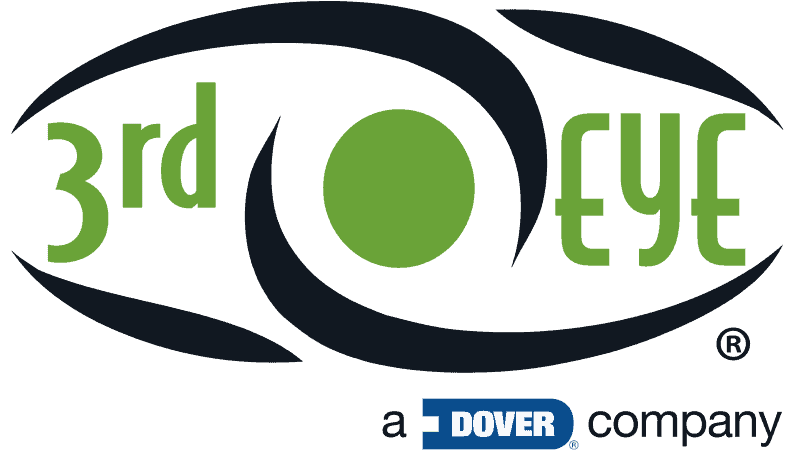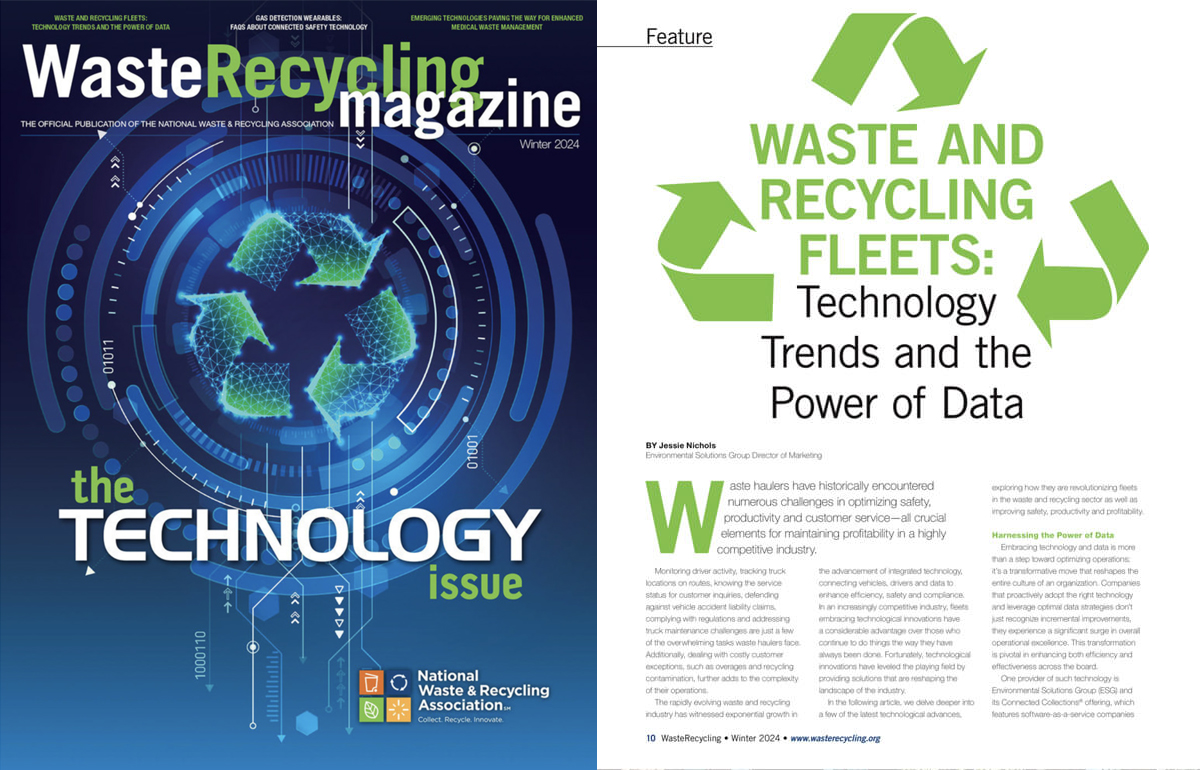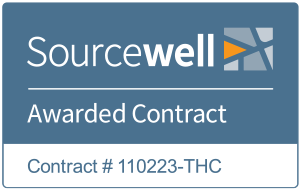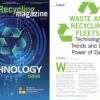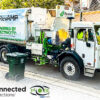Waste and Recycling Fleets: Technology Trends and the Power of Data
BY Jessie Nichols, Environmental Solutions Group Director of Marketing
As seen in WasteRecycling Magazine – Winter 2024 Issue
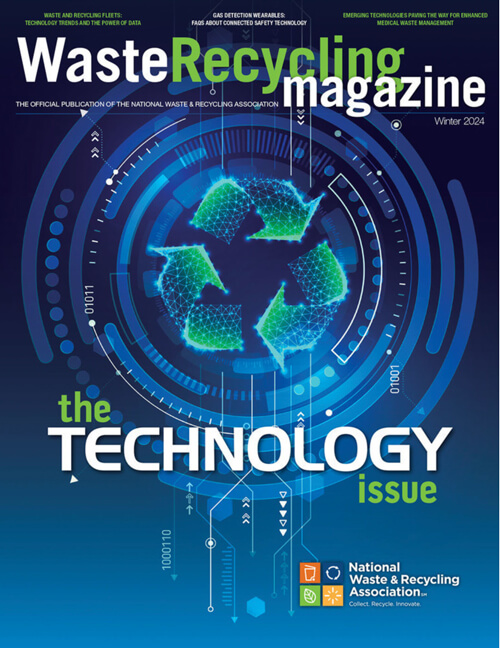 Waste haulers have historically encountered numerous challenges in optimizing safety, productivity and customer service—all crucial elements for maintaining profitability in a highly competitive industry.
Waste haulers have historically encountered numerous challenges in optimizing safety, productivity and customer service—all crucial elements for maintaining profitability in a highly competitive industry.
Monitoring driver activity, tracking truck locations on routes, knowing the service status for customer inquiries, defending against vehicle accident liability claims, complying with regulations and addressing truck maintenance challenges are just a few of the overwhelming tasks waste haulers face. Additionally, dealing with costly customer exceptions, such as overages and recycling contamination, further adds to the complexity of their operations.
The rapidly evolving waste and recycling industry has witnessed exponential growth in the advancement of integrated technology, connecting vehicles, drivers and data to enhance efficiency, safety and compliance. In an increasingly competitive industry, fleets embracing technological innovations have a considerable advantage over those who continue to do things the way they have always been done. Fortunately, technological innovations have leveled the playing field by providing solutions that are reshaping the landscape of the industry.
In the following article, we delve deeper into a few of the latest technological advances, exploring how they are revolutionizing fleets in the waste and recycling sector as well as improving safety, productivity and profitability.
Harnessing the Power of Data
Embracing technology and data is more than a step toward optimizing operations; it’s a transformative move that reshapes the entire culture of an organization. Companies that proactively adopt the right technology and leverage optimal data strategies don’t just recognize incremental improvements, they experience a significant surge in overall operational excellence. This transformation is pivotal in enhancing both efficiency and effectiveness across the board.
One provider of such technology is Environmental Solutions Group (ESG) and its Connected Collections® offering, which features software-as-a-service companies 3rd Eye® and Soft-Pak®. ESG has been at the forefront of the transformation by providing a comprehensive suite of technology solutions that seamlessly integrate vehicles, operators and customer data. These connections provide unparalleled insights that enhance safety, efficiency and profitability, while directly linking municipal, public and private fleets to their customers. A key to Connected Collections’ success is its ability to work with multiple chassis and body original equipment manufacturers with optional factory installations and field retrofits. A fleet strategy that does not work with all vehicles cannot be called a “fleet strategy.”
AI and the Transition to Automation
ESG’s 3rd Eye has been at the forefront of pioneering advancements in artificial intelligence (AI), spearheading the evolution from manual processes to semi-automated and, ultimately, fully automated fleet management systems. By automating tasks that previously required manual actions, drivers are empowered to focus on safely operating their vehicles. This transition not only eliminates potential distractions and reduces inefficiencies but also significantly improves overall fleet safety and productivity.
Safety First
When it comes to safety, 3rd Eye offers comprehensive solutions that incorporate 360-degree camera coverage, including in-cab, exterior and body cameras, all paired with video telematics. Importantly, this 360-degree camera coverage includes immediate video feedback for side-impact collisions as well as front and rear. These systems provide real-time insights into driver, chassis and body activity, offering data that is invaluable for protection against liability and identifying coachable moments to develop safe driving behavior.
In addition to its camera systems, 3rd Eye’s IRIS Collision Warning Radar assists drivers by alerting them to unseen vehicles and obstacles. Custom developed to meet the unique challenges of the waste industry, it is able to detect multiple small objects simultaneously. Unlike traditional fan pattern radars, the IRIS system utilizes narrowly focused detection zones, ensuring superior obstruction detection while allowing drivers to focus on their tasks without distraction. It can be programmed for forward and side exclusion zones, effectively preventing false alarms. This design ensures that body side ladders, chains or hooks do not trigger alarms, while still activating for obstructions as close as three feet.
Safety technology’s influence extends beyond just the equipment; it plays a pivotal role in creating a safety-centric culture. Drivers not only understand the importance of safety but also recognize its alignment with efficiency and outstanding customer service. This marks a significant paradigm shift in the industry. Through real-time monitoring, custom-tailored driver coaching tools and extensive camera coverage, drivers are empowered to embrace safer practices, minimize collision risks and enhance overall fleet safety.
John Andel, safety director for Leck Waste Services and 3rd Eye customer, says, “There are plenty of drive cam companies out there, but 3rd Eye is made by the waste industry for the waste industry. Anyone in this business understands there are a lot of unique factors that 3rd Eye is able to address that other companies simply cannot.”
Positive Service Verification
The task of accurately tracking when, where and what service is performed on routes is critical, yet it presents significant challenges for haulers. Relying on manual notations at each stop proves to be not only time-consuming but also prone to errors. In addition, many current automated verification methods fall short in reliability, primarily due to mechanical add-ons that struggle to endure the harsh real-world conditions encountered on daily routes. Complicating matters further, fleets operating a variety of collection vehicles are often faced with the predicament of not having a universal solution adaptable to all types of refuse bodies. This lack of a one-size-fits-all solution reinforces the need for more versatile and robust tracking methods in the industry.
The 3rd Eye Verif-Eye® module provides positive service verification to address these issues, offering a robust and comprehensive solution. The module uses automated service event detection, providing time-stamped, geolocated photo/video evidence for each service. This innovative advancement ensures reliable documentation of fleet performance without requiring manual action from drivers. The system’s passive event detection prioritizes driver safety and efficiency, and its durable hardware is tailor-made for harsh collection environments.
Leveraging advanced customer association logic, 3rd Eye organizes and presents service history from a customer-by-customer perspective, allowing fleets to understand exactly what happened at each scheduled stop on their routes. Equipped with reliable data from the Verif-Eye module, customer service teams can quickly address inquiries, while operations can monitor route performance, identify trends and make data-driven decisions. The data can seamlessly integrate with existing systems and lay the foundation for tools like exception reviews.
To further enhance efficiency for fleets using Soft-Pak waste hauler software, all verifications seamlessly integrate into the backend billing platform, automatically becoming part of the customer’s permanent records for billing purposes.
Jonathan Winters, operations manager for Winters Bros. Waste Systems and 3rd Eye and Soft-Pak customer, says, “At Winters Bros., we embrace technology because it helps us make better decisions to run our business. I would say every truck should be equipped with Connected Collections technology because detailed data and photos of every pickup give you complete insight into exactly what’s taking place at each customer’s stop. Plus, the safety benefits and overall productivity increases resulting from 3rd Eye and Soft-Pak technology have been a major part of our company’s success.”
Automated Contamination Detection
One of the most significant changes in the waste industry surrounds the issue of contamination. With the implementation of regulations like SB 1383, California’s Short-Lived Climate Pollutant Reduction law, there is an increased focus on organics compliance and the reduction of contaminants in recycling streams. Automated contamination detection systems are becoming vital to preventing materials recovery facility and non-compliance fines, meeting expanding regulations and increasing the value of recycled commodities.
Specialized cameras strategically mounted in the hopper of the refuse collection body are required to analyze the contents of every collection. 3rd Eye’s advanced technology automatically identifies and documents contamination and associates the event to the customer, providing video documentation that can be used to enforce regulations by informing, warning or fining non-compliant generators for repeated occurrences of contamination. Most importantly, this proactive approach revolutionizes waste processing by reducing contamination at the source, all fully automated, without requiring any manual action from drivers.
Automated Exception Detection
In the ever-evolving refuse collection industry, it has become increasingly essential to harness the power of technology to detect, document and recapture costs for service exceptions that were previously unbillable or required ineffective and time-consuming manual operator actions.
3rd Eye Automated Exception Detection technology harnesses the power of AI to passively identify overages and other billable exceptions, effectively eliminating the need for manual input from drivers. This innovation significantly streamlines the billing process by automating the invoicing for these exceptions. More importantly, by accurately capturing costs that were previously unbilled, this system provides waste haulers with critical insights into their operational inefficiencies. The integration of such advanced technologies promises a future of heightened efficiency, improved accuracy and increased revenue generation within the industry. This progression not only optimizes operations but also contributes to more sustainable and economically sound waste management practices.
Fleet Maintenance
Due to significant truck shortages and a reduced number of truck service personnel, it is imperative to enhance fleet uptime and minimize the need for spare vehicles. This approach is crucial for maintaining a healthy fleet capable of consistently meeting route demands.
Automated technology not only continuously monitors both the chassis and body but also proactively identifies potential maintenance issues. This technology takes it a step further by automatically generating work orders in a fleet’s system, ordering all the necessary parts for repairs and providing detailed instructions for the required work and its execution.
By leveraging this technology, fleets can anticipate issues, streamline maintenance processes and ultimately ensure uninterrupted service to clients.
Department of Transportation Compliance and Fuel Tax Reporting
Effective compliance navigation in the waste industry requires collecting accurate data, understanding various governmental requirements and maintaining a detailed paper trail for potential audits. The Certif-Eye® module from 3rd Eye simplifies this process by capturing essential vehicle information, translating it into actionable insights and assisting businesses in their International Fuel Tax Agreement or federal excise tax filings. Utilizing such advanced systems enables businesses to alleviate administrative burdens. This shift allows drivers to concentrate more on their primary responsibilities and less on paperwork. Collaborating with experienced partners can optimize data management and ensure businesses consistently meet their regulatory and contractual obligations.
Conclusion
As the landscape of waste management undergoes its continued transformative evolution, the pivotal role of technology and data integration has become increasingly clear. With a steady stream of advancements on the horizon, the waste and recycling sector has entered an era of unparalleled efficiency, enhanced safety and increased commitment to sustainability. This transformative shift paves the way for a future where waste management seamlessly aligns with technological progress, leading to smarter, more effective and environmentally responsible practices.
